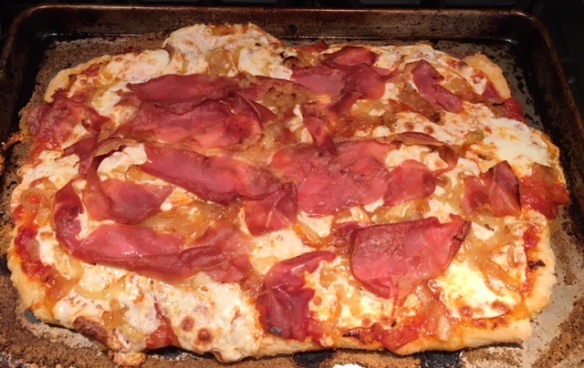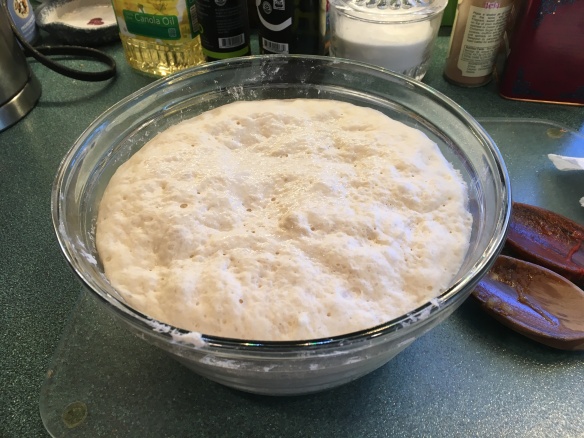
I’ve made and bought a lot of pizza dough. This one is a keeper. I stumbled upon this recipe in the New York Times Cooking section. It’s called “Roberta’s Pizza Dough.” It’s from a restaurant in Brooklyn, so how can it be wrong? The secret to this pizza dough is the flour used. To get a more elastic and flavorful dough, they use 00 flour. This is a superfine Italian flour that has high levels of protein and approximately 12.5% gluten. Gluten levels are controlled by the selection of different wheats for processing. The gluten and protein levels appear to vary somewhat between brands. They all are finely milled. The original recipe includes weights. I don’t have a scale so I went by measurements. It’s a little finicky about the measurement of flour. I read in the comments that you could do equal parts. I’ve always followed the recipe. There is also a video demonstration on how to make it. I strongly suggest you watch it. It’s a simple recipe that requires only one tool…..your hands. You don’t need a mixer or food processor to make this. It keeps in the fridge for up to a week, and it freezes well. I didn’t think it would make a difference but it does. As my grandmothers would say, “Feel the dough.” It’s much lighter than doughs made with all-purpose flour. It doesn’t pull back when you stretch it out in a pan. It feels more delicate. It’s delicious.
Let’s make some pizza!
1 cup plus 1 tablespoon 00 flour
1 cup plus 1 tablespoon and 2 teaspoons of all-purpose flour
3/4 tsp. yeast
1 tsp. fine sea salt (3/4 tsp. kosher salt is what I used)
1 tsp. extra-virgin olive oil
In a large mixing bowl, combine the flours and salt. To measure the flour, scoop flour into measuring cup. Don’t dig down into the flour container with the measuring cup. The amounts are different. I level off the measuring cup with the flat side of a knife.
In a small mixing bowl, stir together lukewarm tap water, yeast and olive oil. I used the rapid rise yeast, so I mix it in with the flours. Make sure the water is under 110 degrees. If you don’t have a thermometer to measure it, pour warm water into the measuring cup and let it sit for 20 minutes. If it’s too hot, the water will kill the yeast. Cooled water will just add to rising time. This recipe called for a little less than one cup of water. I found it works best at the halfway mark between 3/4 and 1 cup. Look at the glass measuring cup at eye level. I found the dough worked better with this amount of water. Pour the liquids into the flour mixture. I cupped my hand and just stirred it until it all came together. Knead it in the bowl for about 3 minutes, after it comes together. Let the mixture rest for 15 minutes. Set a timer!
Knead the rested dough for another 3 minutes, in the bowl. I read in the comments to let it sit on the counter for a half hour at this point. The yeast starts to work its magic. After a half hour, you cut the dough into half if you’re making two 12″ pizzas. I use a cookie sheet, so I don’t divide my dough. I leave it in the bowl, covered with plastic wrap. I usually do this the night before I want to use the pizza dough. I put it in the fridge overnight. Take it out at least one hour before using it. To hurry up the rising process, I turn my oven on to 200 degrees, and place the covered glass bowl on the stove top. The heat comes up from the oven and helps the dough rise, faster. You can take it off and put it on, if the glass bowl feels too hot. If you have the time, you can let it rise on the counter, still covered, for a couple of hours. I like to see the dough bubble. If you are using it the same day, let it rise at room temperature for up to 4 hours. The dough pictured below was just a little mound that barely covered the bottom of the bowl. Yeast is magic! It’s a great science experiment.

I put a coating of olive oil on my pan. Sometimes I sprinkle cornmeal on the pan (cookie sheet) too. Make sure it’s only under the pizza or the cornmeal will burn. It’s optional. My mother uses oiled glass pie plates. Place the dough in the pan and gently stretch it. It’s elastic, but it doesn’t pull back as much as other doughs. Slowly stretch the dough to the edge of the pan. I like to start in the middle and stretch it outward. Once it’s where you would like it to be, put on your sauce, cheese, and other toppings, then bake. I like to bake it between 400-425 degrees for about 15-20 minutes. I like the edges a light brown. I slip a spatula under the pizza and look to see how golden the bottom of the crust is. It usually sets off the smoke detectors if it’s any higher. The oil is the culprit. The sounding smoke detectors are like a dinner bell in my house. The dough is crisp, light and delicious. Let me know if you like it too.
